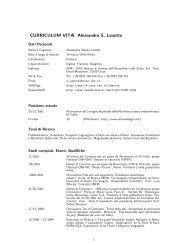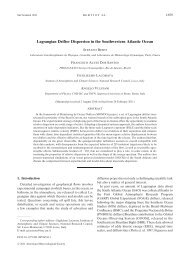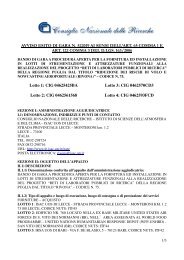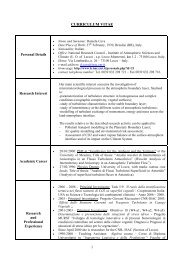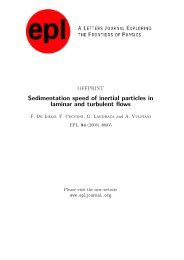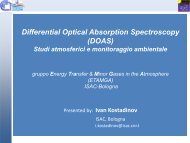Statistical behaviour of isotropic and anisotropic fluctuations in ... - Cnr
Statistical behaviour of isotropic and anisotropic fluctuations in ... - Cnr
Statistical behaviour of isotropic and anisotropic fluctuations in ... - Cnr
You also want an ePaper? Increase the reach of your titles
YUMPU automatically turns print PDFs into web optimized ePapers that Google loves.
Physica D 237 (2008) 1969–1975www.elsevier.com/locate/physd<strong>Statistical</strong> <strong>behaviour</strong> <strong>of</strong> <strong>isotropic</strong> <strong>and</strong> an<strong>isotropic</strong> <strong>fluctuations</strong><strong>in</strong> homogeneous turbulenceLuca Biferale a,b , Aless<strong>and</strong>ra S. Lanotte c,d,∗ , Federico Toschi e,fa Department <strong>of</strong> Physics, University <strong>of</strong> Tor Vergata, Via della Ricerca Scientifica 1, 00133 Rome, Italyb INFN, Sez. Tor Vergata, Via della Ricerca Scientifica 1, 00133 Rome, Italyc CNR - Istituto di Scienze dell’Atmosfera e del Clima, Via Fosso del Cavaliere 100, 00133 Rome, Italyd INFN, Sez. Lecce, 73100 Lecce, Italye CNR - Istituto per le Applicazioni del Calcolo, Viale del Policl<strong>in</strong>ico 137, 00161 Rome, Italyf INFN, Sezione di Ferrara, Via G. Saragat 1, 44100 Ferrara, ItalyAvailable onl<strong>in</strong>e 15 February 2008AbstractWe review recent progresses on anomalous scal<strong>in</strong>g <strong>and</strong> universality <strong>in</strong> an<strong>isotropic</strong> <strong>and</strong> homogeneous hydrodynamic turbulent flows. As acentral matter, we discuss the validity <strong>and</strong> the limits <strong>of</strong> classical ideas <strong>of</strong> statistical isotropy restoration. F<strong>in</strong>ally, we comment on a still open issue,the observed different scal<strong>in</strong>g <strong>behaviour</strong> <strong>of</strong> longitud<strong>in</strong>al <strong>and</strong> transverse velocity <strong>in</strong>crement moments <strong>in</strong> purely statistically <strong>isotropic</strong> ensemble.c 2008 Elsevier B.V. All rights reserved.Keywords: Turbulence; Anisotropy; Intermittency1. Introduction<strong>Statistical</strong> restoration <strong>of</strong> symmetries <strong>of</strong> the Navier–Stokesequations is at the base <strong>of</strong> modern theories <strong>of</strong> turbulence [1].The presence <strong>of</strong> geometrical boundaries or obstacles, or the wayenergy is <strong>in</strong>jected <strong>in</strong> the flow usually break exact symmetries <strong>of</strong>the equation <strong>of</strong> motion. However, for high enough Reynoldsnumber flows, those symmetry properties are supposed to belocally restored <strong>in</strong> a statistical sense, e.g. only for averagequantities. Local homogeneity <strong>and</strong> local isotropy deserve aparticular attention, s<strong>in</strong>ce they are key features <strong>of</strong> theoreticalapproaches to turbulence <strong>and</strong> transport models. While therehas been just a few attempts to make a systematic theory fordeviations from statistical homogeneity [2] (see also [3,4] forrecent results), it is remarkable that about isotropy restoration,there has been a considerable progress <strong>in</strong> the last years, asreviewed <strong>in</strong> Ref. [5]. As a result <strong>of</strong> this progress, effectivedata analysis <strong>and</strong> systematic theoretical studies have beenpossible, such as to separate <strong>isotropic</strong> from an<strong>isotropic</strong> features∗ Correspond<strong>in</strong>g author. Tel.: +39 06 4993 4289.E-mail address: a.lanotte@isac.cnr.it (A.S. Lanotte).<strong>of</strong> turbulent homogeneous statistical <strong>fluctuations</strong>. Motivationfor these researches is related to puzzl<strong>in</strong>g experimental <strong>and</strong>numerical observations, dubbed persistence <strong>of</strong> anisotropies,contradict<strong>in</strong>g classical expectations <strong>of</strong> recovery <strong>of</strong> isotropy[6–9]. Persistence <strong>of</strong> anisotropy accounts for the fact that purelyan<strong>isotropic</strong> adimensional quantities, such as the skewness <strong>of</strong>velocity gradients transverse to the mean flow do not decay, butrema<strong>in</strong> order O(1) at very large Reynolds numbers.On a more general perspective, a proper underst<strong>and</strong><strong>in</strong>g <strong>of</strong>scal<strong>in</strong>g <strong>behaviour</strong>s <strong>in</strong> statistically homogeneous but an<strong>isotropic</strong>flows is crucial to assess the universality <strong>of</strong> statistical properties<strong>of</strong> hydrodynamic turbulence [10].Some crucial steps toward a clear underst<strong>and</strong><strong>in</strong>g <strong>of</strong> thestatistics <strong>of</strong> an<strong>isotropic</strong> <strong>fluctuations</strong> have been done <strong>in</strong> thecontext <strong>of</strong> Kraichnan models [11–13], simple l<strong>in</strong>ear models forpassive transport <strong>of</strong> scalar or vector quantities by homogeneous,<strong>isotropic</strong> <strong>and</strong> Gaussian velocity fields, <strong>in</strong> the presence <strong>of</strong> largescalehomogeneous but an<strong>isotropic</strong> forc<strong>in</strong>g [14–18]. Whilewe cannot review these works, it is worth to recall theirfundamental results. Isotropic <strong>and</strong> an<strong>isotropic</strong> <strong>fluctuations</strong>can be characterized by different scal<strong>in</strong>g exponents, whosestatistical importance is governed by their degree <strong>of</strong> anisotropy;these exponents are <strong>in</strong>dependent <strong>of</strong> large-scale forc<strong>in</strong>g or0167-2789/$ - see front matter c 2008 Elsevier B.V. All rights reserved.doi:10.1016/j.physd.2008.02.008
1970 L. Biferale et al. / Physica D 237 (2008) 1969–1975boundary conditions, hence universal (see also [19] for adiscussion <strong>of</strong> the case <strong>in</strong> the presence <strong>of</strong> an an<strong>isotropic</strong> <strong>and</strong><strong>in</strong>homogeneous forc<strong>in</strong>g). The symmetry break<strong>in</strong>g <strong>and</strong> peculiarnature <strong>of</strong> the forc<strong>in</strong>g is revealed <strong>in</strong> the coefficients appear<strong>in</strong>g <strong>in</strong>the scal<strong>in</strong>g laws, which are not universal.In the absence <strong>of</strong> analytical approaches able to show thevalidity <strong>of</strong> these results <strong>in</strong> the full nonl<strong>in</strong>ear problem, accurateexperimental [20–24] <strong>and</strong> numerical [25–31] measurementsbecome <strong>of</strong> fundamental importance. Encompass<strong>in</strong>g all resultsachieved so far, or attempt<strong>in</strong>g an historical review <strong>of</strong> differentapproaches to homogeneous <strong>isotropic</strong> – where an<strong>isotropic</strong>effects are neglected, – <strong>and</strong> an<strong>isotropic</strong> turbulence, go beyondour goal <strong>and</strong> can be found <strong>in</strong> Ref. [5]. Also we mentionthat different approaches to anisotropy, ma<strong>in</strong>ly focused onlarge scale flow properties, have been extensively studied <strong>in</strong>Ref. [32].Our focus is on small-scale anisotropy. At this purpose,we will first discuss the use <strong>of</strong> the SO(3) decomposition <strong>of</strong>statistical observables <strong>in</strong> terms <strong>of</strong> their projections on differentsectors <strong>of</strong> the group <strong>of</strong> rotations <strong>in</strong> three dimensions [33](see also Ref. [34] for a rewiew focus<strong>in</strong>g on experimentalmeasurements). The use <strong>of</strong> SO(3) decomposition, provid<strong>in</strong>ga complete basis for angular decomposition, enables us tosystematically describe the limits <strong>of</strong> the idea <strong>of</strong> isotropyrestoration at sufficiently small scales (or sufficiently highReynolds number), as postulated by the Kolmogorov theory [1].Key work<strong>in</strong>g hypothesis, that we will discuss <strong>in</strong> the sequel, isthat forc<strong>in</strong>g has its support at scales much larger than those <strong>of</strong>the <strong>in</strong>ertial range.Secondly, we will consider the specific case <strong>of</strong> largescaleshear flows, for which a theoretical prediction forthe dimensional scal<strong>in</strong>g <strong>of</strong> exponents <strong>of</strong> velocity <strong>in</strong>crementmoments (structure functions) <strong>of</strong> any order <strong>and</strong> any degree <strong>of</strong>anisotropy can be done [35]. Results po<strong>in</strong>t to the existence<strong>of</strong> universal <strong>isotropic</strong> <strong>and</strong> an<strong>isotropic</strong> scal<strong>in</strong>g exponents,deviat<strong>in</strong>g from their dimensional values. Anomalous scal<strong>in</strong>g<strong>and</strong> universality <strong>of</strong> turbulent <strong>fluctuations</strong> appear as twoconcepts <strong>in</strong>timately related, as highlighted <strong>in</strong> Kraichnanmodels.F<strong>in</strong>ally, we will consider statistically homogeneous <strong>and</strong><strong>isotropic</strong> turbulent flows, which can be realized with somedegree <strong>of</strong> accuracy <strong>in</strong> experiments <strong>and</strong> <strong>in</strong> numerics. Comparedto strongly an<strong>isotropic</strong> situations as those encountered <strong>in</strong>geophysical or plasma applications, they represent a muchsimpler problem. However, a large number <strong>of</strong> studies[7,22,36–44] report possible different <strong>behaviour</strong>s for thelongitud<strong>in</strong>al <strong>and</strong> transverse velocity structure functions <strong>in</strong> 3Dflows, for moments high enough. These results contradictour expectations (for second <strong>and</strong> third moments, analyticalconstra<strong>in</strong>ts result<strong>in</strong>g from isotropy <strong>and</strong> <strong>in</strong>compressibilityimpose the same scal<strong>in</strong>g to longitud<strong>in</strong>al <strong>and</strong> transverse<strong>fluctuations</strong>). Recent observations will be here reviewed, <strong>and</strong>commented <strong>in</strong> the light <strong>of</strong> the SO(3) decomposition.The paper is organized as follows. Section 2 recallsthe theoretical framework to deal with weak an<strong>isotropic</strong><strong>fluctuations</strong> <strong>and</strong> the notion <strong>of</strong> isotropy recovery; this is doneby means <strong>of</strong> the SO(3) decomposition, briefly sketched.In Section 3, by means <strong>of</strong> the specific case <strong>of</strong> homogeneousshear flows, a dimensional argument for the scal<strong>in</strong>g <strong>of</strong>an<strong>isotropic</strong> <strong>fluctuations</strong> is recalled <strong>and</strong> compared to numericalobservations. Last Section 4, before conclud<strong>in</strong>g remarks, isdevoted to the issue <strong>of</strong> longitud<strong>in</strong>al <strong>and</strong> transverse structurefunctions scal<strong>in</strong>g <strong>in</strong> homogeneous <strong>isotropic</strong> turbulence.2. An<strong>isotropic</strong> hierarchy <strong>and</strong> the SO(3) decompositionThe start<strong>in</strong>g po<strong>in</strong>t <strong>of</strong> a systematic approach to smallscalean<strong>isotropic</strong> turbulence is to suppose that both boundaryconditions <strong>and</strong> forc<strong>in</strong>g – which break the <strong>in</strong>variance underrotation <strong>of</strong> the Navier–Stokes equations [45], – give adom<strong>in</strong>ant contribution only at large scales, while the transfer <strong>of</strong><strong>fluctuations</strong> from large to small scales is driven by the rotational<strong>in</strong>variant terms <strong>of</strong> the equations <strong>of</strong> motion. This is equivalentto say that anisotropy is only weakly affect<strong>in</strong>g the statisticalproperties <strong>of</strong> the turbulent field under exam. Strongly shearedflows constitute a noticeable exception [46,47], as well asmagneto-hydrodynamic (MHD) flows <strong>in</strong> the presence <strong>of</strong> a meanfield for which we still do not have clear evidences [48,49].However, when the previous hypothesis <strong>of</strong> large-scale forc<strong>in</strong>gholds, we can study the <strong>behaviour</strong> <strong>of</strong> velocity correlationfunctions <strong>in</strong> the <strong>in</strong>ertial range, at scales η r L whereη is the dissipation scale <strong>and</strong> L is the scale <strong>of</strong> the forc<strong>in</strong>g.To separate <strong>isotropic</strong> from an<strong>isotropic</strong> contributions, itis useful to consider their projections on the irreduciblerepresentations <strong>of</strong> the SO(3) group. As a st<strong>and</strong>ard observable,we consider the two-po<strong>in</strong>ts homogeneous second-orderstructure functionS αβ (r) ≡ (v α (r) − v α (0))(v β (r) − v β (0)) .The decomposition <strong>of</strong> S αβ (r) <strong>in</strong> terms <strong>of</strong> the eigenfunctions<strong>of</strong> the rotational operator is made by a set <strong>of</strong> functionslabelled with the usual <strong>in</strong>dices j = 0, 1,... <strong>and</strong> m =− j,...,+ j, correspond<strong>in</strong>g to the total angular momentum <strong>and</strong>to the projection <strong>of</strong> the total angular momentum on a arbitrarydirection, respectively.For scalars quantities, as the longitud<strong>in</strong>al structure function,S (2)L (r) ≡ [(v(r) − v(0)) ·ˆr] 2 , the set <strong>of</strong> basis functionsare the spherical harmonics, Y jm (ˆr). For a generic pth ordertensor, <strong>in</strong> addition to <strong>in</strong>dices j <strong>and</strong> m, another <strong>in</strong>dex q isnecessary, labell<strong>in</strong>g different irreducible representations with<strong>in</strong>each fixed j sector [5,33]. It is easy to show that there are onlyq = 1,...,6 irreducible representations <strong>of</strong> the SO(3) groupfor the space <strong>of</strong> two-<strong>in</strong>dices symmetrical tensors as S αβ (r).Accord<strong>in</strong>gly, the second order structure function can be exactlydecomposed asS αβ (r) ≡6 ∞+ jq=1 j=0 m=− jS (2)qjm (r)Bαβ qjm(ˆr), (1)where the tensors B αβqjm(ˆr), def<strong>in</strong>ed on the unit sphere, canbe seen as a generalization <strong>of</strong> the spherical harmonics to thetensorial case, <strong>and</strong> the superscript 2 <strong>in</strong> the projection S (2)qjm (r)rem<strong>in</strong>ds the order <strong>of</strong> the analysed correlation function.
L. Biferale et al. / Physica D 237 (2008) 1969–1975 1971In Ref. [33], it has been shown that, if the forc<strong>in</strong>g is atlarge scales, by project<strong>in</strong>g the rotational <strong>in</strong>variant part <strong>of</strong> theevolution equation for S αβ (r) on the irreducible representations<strong>of</strong> the SO(3) group, we obta<strong>in</strong> a set <strong>of</strong> dynamic – unclosed –equations for each projection, <strong>in</strong> each separate sector. The terms<strong>of</strong> the equations that are not coupled with the forc<strong>in</strong>g, do notdepend explicitly on the <strong>in</strong>dex m (<strong>in</strong>variance <strong>of</strong> Navier–Stokeseqs. with respect to the orientation <strong>of</strong> the z-axis) <strong>and</strong> theymix all possible q-representations, for a given j. In otherwords, if forc<strong>in</strong>g terms are neglected, projections obey separatedynamic equations with<strong>in</strong> each j sector, which corresponds tothe foliation <strong>of</strong> the dynamic equation for any correlation <strong>in</strong> eachgiven sector j <strong>of</strong> the rotational group [5]. This is a powerfulresult s<strong>in</strong>ce, if forc<strong>in</strong>g can be neglected at small scales, it allowsto analyse separately the scal<strong>in</strong>g <strong>behaviour</strong> <strong>of</strong> <strong>isotropic</strong> <strong>and</strong>an<strong>isotropic</strong> <strong>fluctuations</strong> <strong>in</strong> a systematic <strong>and</strong> quantitative way bystudy<strong>in</strong>g the <strong>behaviour</strong> <strong>of</strong> the projection coefficients S (2)qjm (r),for any degree <strong>of</strong> anisotropy j.Moreover, <strong>in</strong> the limit <strong>of</strong> <strong>in</strong>f<strong>in</strong>ite Reynolds numbers,Navier–Stokes equations become scal<strong>in</strong>g <strong>in</strong>variant, sector bysector. It is thus natural to expect the existence <strong>of</strong> scal<strong>in</strong>g lawscharacteriz<strong>in</strong>g each sector separately, that is:S (2)qjm(r) ∼ c(2)qjm r ξ j (2) , (2)where the coefficients c (2)jmqhave to be matched with largescaleboundary conditions <strong>and</strong> forc<strong>in</strong>g. Decomposition similarto that <strong>of</strong> Eq. (1) can be generalized to any p-th order tensor,associated to velocity <strong>in</strong>crement moments <strong>of</strong> order p > 2.In pr<strong>in</strong>ciple, noth<strong>in</strong>g prevents the existence <strong>of</strong> more than oneexponent characteriz<strong>in</strong>g each separate an<strong>isotropic</strong> sector, so thatthe power-law <strong>in</strong> Eq. (2) has to be considered the dom<strong>in</strong>antterm.When we deal with numerical or experimental data,measur<strong>in</strong>g <strong>behaviour</strong> <strong>of</strong> undecomposed velocity <strong>in</strong>crementmoments at smaller <strong>and</strong> smaller scales might not be enoughto extract clean results about scal<strong>in</strong>g exponents, even forvery large Reynolds number flows. Indeed the presence <strong>of</strong>an<strong>isotropic</strong> <strong>fluctuations</strong> which have not yet decayed evenat very small scales, can spoil scal<strong>in</strong>g, thus result<strong>in</strong>g <strong>in</strong> asuperposition <strong>of</strong> different power laws.In particular, measur<strong>in</strong>g scal<strong>in</strong>g properties <strong>in</strong> each separatesector becomes compulsory if we mean to assess isotropyrecovery <strong>of</strong> turbulent statistics. Such a recovery may exist onlyif, for any moment <strong>of</strong> given order p, the <strong>isotropic</strong> scal<strong>in</strong>gexponent is always smaller than the an<strong>isotropic</strong> ones,ξ j=0 (p)
1972 L. Biferale et al. / Physica D 237 (2008) 1969–1975The idea is the follow<strong>in</strong>g. The overall effect <strong>of</strong> the largescaleenergy pump<strong>in</strong>g <strong>and</strong>/or boundary conditions is to producea large-scale an<strong>isotropic</strong> driv<strong>in</strong>g velocity field U. This is quitenatural <strong>and</strong> very <strong>of</strong>ten encountered <strong>in</strong> geophysical or laboratoryflows. The time evolution equation for the velocity field v canbe written as∂ t v α + v β ∂ β v α + U β ∂ β v α + v β ∂ β U α =−∂ α p + ν∆v α . (6)The major effect <strong>of</strong> the large-scale field is the <strong>in</strong>stantaneousshear I αβ = ∂ β U α which acts as an an<strong>isotropic</strong> forc<strong>in</strong>g termon small scales, i.e. for scales much smaller than the typicalshear-<strong>in</strong>jection scale, L S = /|I| 3 .To build up a dimensional match<strong>in</strong>g for velocity <strong>fluctuations</strong>,we first consider the equation <strong>of</strong> motion for two po<strong>in</strong>tsquantity v α (r)v δ (0) <strong>in</strong> the stationary regime. Inertial <strong>and</strong>shear-<strong>in</strong>duced contributions can be balanced:vδ (0)v β (r)∂ β v α (r) ∼ I αµ (r)v δ (0)v µ (r) , (7)to obta<strong>in</strong> a dimensional estimate <strong>of</strong> the an<strong>isotropic</strong> components<strong>of</strong> the LHS <strong>in</strong> terms <strong>of</strong> the RHS shear <strong>in</strong>tensity <strong>and</strong> <strong>of</strong> the<strong>isotropic</strong> part <strong>of</strong> v(ˆr)v(0) . Similarly for three po<strong>in</strong>t quantities<strong>and</strong> higher order velocity correlation. S<strong>in</strong>ce the shear is a largescaleslow quantity, a safe estimate is the follow<strong>in</strong>g:Iαµ (r)v δ (0)v µ (r) ∼ D αµvδ (0)v µ (r) .The D αβ tensor, associated to the comb<strong>in</strong>ed probability to havea given shear <strong>and</strong> a given small scale velocity fluctuation, br<strong>in</strong>gsangular momentum only up to j = 2. Composition <strong>of</strong> angularmomenta ( j = 2 ⊕ j − 2), then results <strong>in</strong> the follow<strong>in</strong>gdimensional match<strong>in</strong>g:S (p)j(r) ∼ r|D|·S (p−1) (r), (8)j−2where S (p)j(r) is a shorth<strong>and</strong> notation <strong>of</strong> the projection on thej- th sector <strong>of</strong> the p- th order correlation function previously<strong>in</strong>troduced, neglect<strong>in</strong>g further possible dependencies on q <strong>and</strong>m <strong>in</strong>dices. In Eq. (8), |D| denotes the typical <strong>in</strong>tensity <strong>of</strong> theshear term D αβ <strong>in</strong> the j = 2 sector. For <strong>in</strong>stance, the lead<strong>in</strong>g<strong>behaviour</strong> <strong>of</strong> the j = 2 an<strong>isotropic</strong> sector <strong>of</strong> the third-ordercorrelation is: S (3)j=2(r) ∼ r|D|S(2)j=0 (r) ∼ r ξ d 2(3) .By us<strong>in</strong>g a similar argument, we can obta<strong>in</strong> dimensionalpredictions for the j = 2, 4 sectors <strong>of</strong> the fourth order structurefunction. The procedure is easily extended to all orders, lead<strong>in</strong>gto the follow<strong>in</strong>g expression:ξ jd(p + j)(p) = . (9)3Direct numerical simulations (DNS), at moderate Reynoldsnumber Re λ ∼ 100, <strong>of</strong> a fully periodic, <strong>in</strong>compressible flowwith a statistically homogeneous but an<strong>isotropic</strong> large-scaleenergy <strong>in</strong>jection have been reported <strong>in</strong> Ref. [27,35]. They canbe used to test the validity <strong>of</strong> the dimensional prediction (9).In Fig. 1 <strong>isotropic</strong> <strong>and</strong> an<strong>isotropic</strong> <strong>fluctuations</strong>, which havea signal-to-noise ratio high enough to ensure stable results,are shown. Sectors with odd js are absent due to the paritysymmetry <strong>of</strong> the longitud<strong>in</strong>al structure functions. We notice aFig. 1. Log–log plot <strong>of</strong> the second-order structure function projections S (2)jm (r)versus the scale r, for sectors with a good signal-to-noise ratio. Sectors:( j, m) = (0, 0), (+); ( j, m) = (2, 2), (×); ( j, m) = (4, 0), (empty square);( j, m) = (4, 2), (); ( j, m) = (6, 0), (◦); ( j, m) = (6, 2), (black square).The statistical <strong>and</strong> numerical noise <strong>in</strong>duced by the SO(3) decomposition isestimated as the threshold where the j = 6 sector starts to deviate fromthe monotonic decreas<strong>in</strong>g <strong>behaviour</strong> ∼O(10 −3 ). This figure is taken fromRef. [27]. Data come from the <strong>in</strong>tegration <strong>of</strong> Navier–Stokes equation for an<strong>in</strong>compressible flow, solved on a triply periodic box with 256 3 grid po<strong>in</strong>ts;Taylor scale based Reynolds number is Re λ ∼ 100.clear foliation <strong>in</strong> terms <strong>of</strong> the j <strong>in</strong>dex: sectors with the samej but different ms behave very similarly. In Table 1 the bestpower law fits for structure functions <strong>of</strong> orders p = 2, 4, 6<strong>and</strong> sectors j = 2, 4, 6 are presented. It is important tonotice the presence <strong>of</strong> a hierarchical organization as assumed<strong>in</strong> (4), which implies isotropy restoration at sufficiently smallscales, <strong>and</strong> also that there is no saturation for the exponentsas a function <strong>of</strong> the j value. Second, the measured exponents<strong>in</strong> the sectors j = 4 <strong>and</strong> j = 6 are anomalous, i.e. theydiffer from the dimensional estimate ξ jd(p) = ( j + p)/3.This implies that isotropy is restored at small scales, butsublead<strong>in</strong>g an<strong>isotropic</strong> <strong>fluctuations</strong> decay slower than predictedby dimensional argument. Such difference with the dimensionalscal<strong>in</strong>g has been exploited <strong>in</strong> Ref. [26] to expla<strong>in</strong> the puzzl<strong>in</strong>gresults on gradients statistics mentioned <strong>in</strong> the <strong>in</strong>troduction [6–9]. Persistence <strong>of</strong> anisotropy can be understood <strong>of</strong> a comb<strong>in</strong>edeffect <strong>of</strong> anisotropy <strong>and</strong> <strong>in</strong>termittency, caus<strong>in</strong>g an<strong>isotropic</strong>quantities to decay at high Reynolds at much slower rates thatwhat expected by dimensional predictions (see e.g. Ref. [51]).Moreover, the comparison between new experimental <strong>and</strong>numerical results [24,29,30] with the data presented <strong>in</strong> Table 1suggests that an<strong>isotropic</strong> <strong>fluctuations</strong> are <strong>in</strong>deed universal,i.e. scal<strong>in</strong>g exponents for scales smaller then the typical shearlength do not depend on the particular mechanism used to<strong>in</strong>ject anisotropy. A different scenario may emerge if we lookat scal<strong>in</strong>g properties for scales larger than the typical shearlength, L S , i.e. where the external forc<strong>in</strong>g mechanism cannotbe neglected <strong>and</strong> therefore the foliation pattern is no longervalid [30,46,47] (consider for example turbulent convection <strong>in</strong>the Bolgiano regime). If foliation cannot be <strong>in</strong>voked, all sectorsare <strong>in</strong> pr<strong>in</strong>ciple entangled <strong>and</strong> scal<strong>in</strong>g properties <strong>of</strong> <strong>isotropic</strong><strong>and</strong> an<strong>isotropic</strong> sectors may even become not universal. Furtherwork is needed <strong>in</strong> this direction, by compar<strong>in</strong>g experimentswith different <strong>in</strong>jection mechanisms to better highlight thestatistical <strong>behaviour</strong> at scales r L S .
L. Biferale et al. / Physica D 237 (2008) 1969–1975 1973Table 1Scal<strong>in</strong>g exponents <strong>in</strong> the <strong>isotropic</strong> <strong>and</strong> an<strong>isotropic</strong> sectors obta<strong>in</strong>ed <strong>in</strong> Refs. [27,35] by means <strong>of</strong> DNSp ξ j=0 (p) [ξ j=0d (p)] ξ j=2 (p) [ξ j=2d (p)] ξ j=4 (p) [ξ j=4d (p)] ξ j=6 (p) [ξ j=6d (p)]2 0.70 ± 0.2 [0.66] 1.15 ± 0.5 [1.33] 1.65 ± 0.5 [2.00] 3.2 ± 0.2 [2.66]4 1.28 ± 0.4 [1.33] 1.56 ± 0.5 [2.00] 2.25 ± 0.1 [2.66] 3.1 ± 0.2 [3.33]6 1.81 ± 0.6 [2.00] 2.07 ± 0.8 [2.33] 2.60 ± 0.1 [3.33] 3.3 ± 0.2 [4.00]Notice that values for the an<strong>isotropic</strong> sector j = 2, at different order moment order p, are taken from the experiments [21,22]. For the values extracted from thenumerical simulation (columns j = 0, 4, 6), error bars are estimated on the oscillation <strong>of</strong> the local slopes. For the experimental data, error bars are given as themismatch between the two experiments. For all sectors, the dimensional estimates for the scal<strong>in</strong>g exponents ξ jd (p) = (p + j)/3 are also reported <strong>in</strong> square brackets.4. Discussions <strong>and</strong> open issuesAn issue still much debated concerns scal<strong>in</strong>g <strong>in</strong> purely<strong>isotropic</strong> ensemble. Velocity tensors can be decomposed, <strong>in</strong>sidethe j = 0 <strong>isotropic</strong> sector, <strong>in</strong> q-different eigenvectors,correspond<strong>in</strong>g for example to purely longitud<strong>in</strong>al, purelytransverse or mixed longitud<strong>in</strong>al <strong>and</strong> transverse <strong>fluctuations</strong> [5].Purely longitud<strong>in</strong>al structure functions are given by S (p)L(r) ≡[δv(r) · ˆr] p ; purely transverse structure functions are:(r) ≡ [δv(r T )] p (where r T · v = 0). As previouslydiscussed, arguments based on SO(3) decomposition donot dist<strong>in</strong>guish among scal<strong>in</strong>g properties <strong>in</strong>side a given jsector. If different scal<strong>in</strong>g are observed among transverse <strong>and</strong>longitud<strong>in</strong>al <strong>fluctuations</strong> with<strong>in</strong> the j = 0 sector for statistically<strong>isotropic</strong> flows, new ideas must be presented to expla<strong>in</strong> them.In Fig. 2, we show a comparison between logarithmic localslopes <strong>of</strong> order p = 8 <strong>and</strong> p = 4 <strong>in</strong> the ESS sense [52,53],<strong>of</strong> longitud<strong>in</strong>al <strong>and</strong> transverse structure functions [36,54]:S (p)Tζ(p, r) =d log S(p)L,T (r)d log S (2)L,T (r),for data issu<strong>in</strong>g from two different numerical simulations. Thisis equal to the ratio <strong>of</strong> the scal<strong>in</strong>g exponent <strong>of</strong> the p-th orderlongitud<strong>in</strong>al (transverse) structure function to that <strong>of</strong> the secondorder longitud<strong>in</strong>al (transverse) one. The two DNS are ideallystatistically <strong>isotropic</strong> s<strong>in</strong>ce the forc<strong>in</strong>g mechanism is such, <strong>and</strong>the flow has periodic boundary conditions. Residual an<strong>isotropic</strong>contribution due to the discretized nature <strong>of</strong> the numerical grid<strong>and</strong> to statistical <strong>fluctuations</strong> <strong>in</strong> the velocity statistics <strong>in</strong>ducedby the forc<strong>in</strong>g, can be quantified <strong>and</strong> result to be very small<strong>in</strong> the data shown here. Still, <strong>in</strong> the <strong>in</strong>ertial range the twodatasets agree <strong>in</strong> show<strong>in</strong>g a detectable difference between thelongitud<strong>in</strong>al <strong>and</strong> the transverse scal<strong>in</strong>g exponents.This discrepancy is an open theoretical issue, not expla<strong>in</strong>ableus<strong>in</strong>g st<strong>and</strong>ard symmetry argument <strong>in</strong> homogeneous <strong>and</strong><strong>isotropic</strong> turbulence [5]. If this is an effect due to f<strong>in</strong>ite-Reynolds number or a result which rema<strong>in</strong>s true even for most<strong>in</strong>tense turbulent realizations is yet not known (see also [39] fora discussion on this po<strong>in</strong>t).In recent years, many detailed observations about an<strong>isotropic</strong>turbulence have been collected. These have also given a burstfor develop<strong>in</strong>g a systematic theory for disentangl<strong>in</strong>g <strong>isotropic</strong><strong>and</strong> an<strong>isotropic</strong> <strong>fluctuations</strong> <strong>in</strong> the case <strong>of</strong> statistically homogeneousturbulent flows. We have now observation <strong>of</strong>statistical restoration <strong>of</strong> isotropy <strong>in</strong> passive transport <strong>and</strong> hydrodynamicturbulence. However, isotropy is recovered at a slowerFig. 2. Top figure: Log-l<strong>in</strong> plot <strong>of</strong> the local slopes, <strong>in</strong> ESS, <strong>of</strong> the 8th-orderlongitud<strong>in</strong>al (top l<strong>in</strong>es) <strong>and</strong> transverse (bottom l<strong>in</strong>es) structure functions versusthe scale r/η, as obta<strong>in</strong>ed from DNS data <strong>of</strong> <strong>in</strong>compressible turbulence fromRef. [36], (DNS1: circles). These are compared with DNS data obta<strong>in</strong>edfor a slightly compressible turbulent flow, as reported <strong>in</strong> Ref. [54], (DNS2:squares). Bottom figure: The same but for the fourth-order longitud<strong>in</strong>al <strong>and</strong>transverse structure functions. Note the good agreement <strong>of</strong> the two datasets<strong>in</strong> the <strong>in</strong>ertial range, r η, where they display the same mismatch betweenthe longitud<strong>in</strong>al <strong>and</strong> transverse moments. The discrepancy between DNS1 <strong>and</strong>DNS2 data close to the dissipative scale, r/η ∼ 1, is due to the fact that the twosimulations have different small-scale dissipation mechanisms. DNS1 data referto an <strong>in</strong>compressible turbulent flow, with normal viscous dissipation; numericalresolution is 1024 3 grid po<strong>in</strong>ts <strong>and</strong> Taylor scale-based Reynolds number isRe λ ∼ 460. DNS2 data refer to a slightly compressible turbulent flow withMach number ∼ 0.3; numerical resolution is 1856 3 grid po<strong>in</strong>ts, <strong>and</strong> estimatedReynolds number is Re λ ∼ 600. In this run, there are two mechanisms <strong>of</strong>k<strong>in</strong>etic energy dissipation. The most important is the transformation <strong>of</strong> k<strong>in</strong>eticenergy <strong>in</strong>to heat via compressible effects; the second is a numerical smooth<strong>in</strong>g<strong>of</strong> steep velocity gradients tuned to filter out local numerical <strong>in</strong>stabilities. Thelatter is important only at scales <strong>of</strong> the order <strong>of</strong> the grid spac<strong>in</strong>g.rate than expected by dimensional argument, due to <strong>in</strong>termittency.Also, there are evidences that an<strong>isotropic</strong> exponents, aswell as <strong>isotropic</strong> ones, are anomalous <strong>and</strong> universal. Numerical<strong>and</strong> experimental results match with the analytical results obta<strong>in</strong>ed<strong>in</strong> l<strong>in</strong>ear model for passive advection, where it has beenshown the existence <strong>of</strong> a hierarchy <strong>of</strong> exponents depend<strong>in</strong>g onthe anisotropy degree, as well as the <strong>in</strong>termittency <strong>and</strong> universality<strong>of</strong> these exponents.Our underst<strong>and</strong><strong>in</strong>g <strong>of</strong> an<strong>isotropic</strong> turbulence is, however,based on the idea that boundary conditions <strong>and</strong> forc<strong>in</strong>gcontribute only at large scales, <strong>and</strong> do not break rotational<strong>in</strong>variance at scales <strong>in</strong> the <strong>in</strong>ertial range. This might not bealways true, particularly if we consider the case <strong>of</strong> MHD
1974 L. Biferale et al. / Physica D 237 (2008) 1969–1975turbulence, for which there are observations that anisotropy cangrow go<strong>in</strong>g at smaller <strong>and</strong> smaller scales [48]. Similarly, shearflows <strong>in</strong> the production range or turbulent convection <strong>in</strong> theBolgiano regime may posses strong departure from the sort <strong>of</strong>phenomenology observed with<strong>in</strong> the foliation scheme.AcknowledgmentsWe acknowledge long-last<strong>in</strong>g collaboration <strong>and</strong> discussionswith many colleagues, that have contributed to shape ourunderst<strong>and</strong><strong>in</strong>g <strong>of</strong> the problem. In particular, we want to thankI. Arad, A. Celani, C.M. Casciola, I. Daumont, D. Lohse,B. Jacob, I. Mazzitelli, A. Mazz<strong>in</strong>o, I. Procaccia <strong>and</strong> M.Vergassola. We also thank T. Gotoh <strong>and</strong> the FLASH center <strong>in</strong>Chicago, <strong>in</strong> particular R. Fisher <strong>and</strong> D. Lamb, for shar<strong>in</strong>g withus the DNS data published <strong>in</strong> Ref. [36,54], respectively.References[1] U. Frisch, Turbulence, <strong>in</strong>: The Legacy <strong>of</strong> A.N. Kolmogorov, CambridgeUniversity Press, Cambridge, 1995.[2] A.S. Mon<strong>in</strong>, A.M. Yaglom, <strong>Statistical</strong> Fluid Mechanics: Mechanics <strong>of</strong>Turbulence, vol. 2, MIT Press, 1975.[3] U. Frisch, J. Bec, E. Aurell, Locally homogeneous turbulence: Is it an<strong>in</strong>consistent framework? Phys. Fluids 17 (2005) 081706.[4] A. Celani, M.M. Afonso, A. Mazz<strong>in</strong>o, Po<strong>in</strong>t-source scalar turbulence,J. Fluid Mech. 583 (2007) 189.[5] L. Biferale, I. Procaccia, Anisotropy <strong>in</strong> turbulent flows <strong>and</strong> <strong>in</strong> turbulenttransport, Phys. Rep. 414 (2005) 43.[6] A. Pumir, B.I. Shraiman, Persistent small scale anisotropy <strong>in</strong>homogeneous shear flows, Phys. Rev. Lett. 75 (1995) 3114.[7] X. Shen, Z. Warhaft, The anisotropy <strong>of</strong> the small scale structure <strong>in</strong> highReynolds number (R lambda 1000) turbulent shear flow, Phys. Fluids 12(2000) 2976.[8] J. Schumacher, K. Sreenivasan, P.K. Yeung, Derivative moments <strong>in</strong>turbulent shear flows, Phys. Fluids 15 (2003) 84.[9] J. Schumacher, Relation between shear parameter <strong>and</strong> Reynolds number<strong>in</strong> statistically stationary turbulent shear flows, Phys. Fluids 16 (2004)3094.[10] K.R. Sreenivasan, R.A. Antonia, The phenomenology <strong>of</strong> small-scaleturbulence, Annu. Rev. Fluid Mech. 29 (1997) 435.[11] R.H. Kraichnan, Anomalous scal<strong>in</strong>g <strong>of</strong> a r<strong>and</strong>omly advected passivescalar, Phys. Rev. Lett. 72 (1994) 1016.[12] K. Gawȩdzki, A. Kupia<strong>in</strong>en, Anomalous scal<strong>in</strong>g <strong>of</strong> the passive scalar,Phys. Rev. Lett. 75 (1995) 3834.[13] M. Vergassola, Anomalous scal<strong>in</strong>g for passively advected magnetic fields,Phys. Rev. E 53 (1996) R3021.[14] A.S. Lanotte, A. Mazz<strong>in</strong>o, An<strong>isotropic</strong> nonperturbative zero modes forpassively advected magnetic fields, Phys. Rev. E 60 (1999) R3483.[15] I. Arad, L. Biferale, I. Procaccia, Nonperturbative spectrum <strong>of</strong> anomalousscal<strong>in</strong>g exponents <strong>in</strong> the an<strong>isotropic</strong> sectors <strong>of</strong> passively advectedmagnetic fields, Phys. Rev. E 61 (2000) R2654.[16] I. Arad, V. L’vov, E. Podivilov, I. Procaccia, Anomalous scal<strong>in</strong>g <strong>in</strong> thean<strong>isotropic</strong> sectors <strong>of</strong> the Kraichnan model <strong>of</strong> passive scalar advection,Phys. Rev. E 62 (2000) 4904.[17] N.V. Antonov, J. Honkonen, Anomalous scal<strong>in</strong>g <strong>in</strong> two models <strong>of</strong> passivescalar advection: Effects <strong>of</strong> anisotropy <strong>and</strong> compressibility, Phys. Rev. E63 (2001) 036302.[18] I. Arad, I. Procaccia, Spectrum <strong>of</strong> an<strong>isotropic</strong> exponents <strong>in</strong> hydrodynamicsystems with pressure, Phys. Rev. E 63 (2001) 056302.[19] M.M. Afonso, M. Sbragaglia, Inhomogeneous an<strong>isotropic</strong> passive scalars,J. Turbul. 6 (10) (2005).[20] I. Arad, B. Dhruva, S. Kurien, V.S. L’vov, I. Procaccia, K.R. Sreenivasan,Extraction <strong>of</strong> an<strong>isotropic</strong> contributions <strong>in</strong> turbulent flows, Phys. Rev. Lett.81 (1998) 5330.[21] S. Kurien, K.R. Sreenivasan, An<strong>isotropic</strong> scal<strong>in</strong>g contributions to highorderstructure functions <strong>in</strong> high-Reynolds-number turbulence, Phys. Rev.E 62 (2000) 2206.[22] X. Shen, Z. Warhaft, Longitud<strong>in</strong>al <strong>and</strong> transverse structure functions <strong>in</strong>sheared <strong>and</strong> unsheared w<strong>in</strong>d-tunnel turbulence, Phys. Fluids 14 (2002)370.[23] X. Shen, Z. Warhaft, On the higher order mixed structure functions <strong>in</strong>laboratory shear flow, Phys. Fluids 14 (2002) 2432.[24] B. Jacob, L. Biferale, G. Iuso, C.M. Casciola, An<strong>isotropic</strong> <strong>fluctuations</strong> <strong>in</strong>turbulent shear flows, Phys. Fluids 16 (2004) 4135.[25] I. Arad, L. Biferale, I. Mazzitelli, I. Procaccia, Disentangl<strong>in</strong>g scal<strong>in</strong>gproperties <strong>in</strong> an<strong>isotropic</strong> <strong>and</strong> <strong>in</strong>homogeneous turbulence, Phys. Rev. Lett.82 (1999) 5040.[26] L. Biferale, M. Vergassola, Isotropy vs anisotropy <strong>in</strong> small-scaleturbulence, Phys. Fluids 13 (2001) 2139.[27] L. Biferale, F. Toschi, Anisotropies <strong>in</strong> homogeneous turbulence:Hierarchy <strong>of</strong> scal<strong>in</strong>g exponents <strong>and</strong> <strong>in</strong>termittency <strong>of</strong> the an<strong>isotropic</strong>sectors, Phys. Rev. Lett. 86 (2001) 4831.[28] L. Biferale, D. Lohse, I. Mazzitelli, F. Toschi, Prob<strong>in</strong>g structures <strong>in</strong>channel flow through SO(3) <strong>and</strong> SO(2) decomposition, J. Fluid Mech. 452(2002) 39.[29] C.M. Casciola, P. Gualtieri, B. Jacob, R. Piva, Scal<strong>in</strong>g properties <strong>in</strong> theproduction range <strong>of</strong> shear dom<strong>in</strong>ated flows, Phys. Rev. Lett. 95 (2005)024503.[30] C.M. Casciola, P. Gualtieri, B. Jacob, R. Piva, The residual anisotropy atsmall scales <strong>in</strong> high shear turbulence, Phys. Fluids 19 (2007) 101704.[31] M. Antonelli, A.S. Lanotte, A. Mazz<strong>in</strong>o, Anisotropies <strong>and</strong> universality<strong>of</strong> buoyancy-dom<strong>in</strong>ated turbulent <strong>fluctuations</strong>: A large-eddy simulationstudy, J. Atmos. Sci. 64 (2007) 2642–2656.[32] C. Cambon, J.F. Scott, L<strong>in</strong>ear <strong>and</strong> nonl<strong>in</strong>ear models <strong>of</strong> an<strong>isotropic</strong>turbulence, Annu. Rev. Fluid Mech. 31 (1999) 1.[33] I. Arad, V. L’vov, I. Procaccia, Correlation functions <strong>in</strong> <strong>isotropic</strong> <strong>and</strong>an<strong>isotropic</strong> turbulence: The role <strong>of</strong> the symmetry group, Phys. Rev. E 59(1999) 6753.[34] S. Kurien, K.R. Sreenivasan, Measures <strong>of</strong> anisotropy <strong>and</strong> the universalproperties <strong>of</strong> turbulence, <strong>in</strong>: M. Lesieur, A. Yaglom, F. David (Eds.), LesHouches 2000: New Trends <strong>in</strong> Turbulence, Spr<strong>in</strong>ger EDP-Sciences, 2001.[35] L. Biferale, I. Daumont, A. Lanotte, F. Toschi, Anomalous <strong>and</strong>dimensional scal<strong>in</strong>g <strong>in</strong> an<strong>isotropic</strong> turbulence, Phys. Rev. E 66 (2002)056306.[36] T. Gotoh, D. Fukayama, T. Nakano, Velocity field statistics <strong>in</strong>homogeneous steady turbulence obta<strong>in</strong>ed us<strong>in</strong>g a high-resolution directnumerical simulation, Phys. Fluids 14 (2002) 1065.[37] B. Dhruva, Y. Tsuji, K.R. Sreenivasan, Transverse structure functions <strong>in</strong>high-Reynolds-number turbulence, Phys. Rev. E 56 (1997) R4928.[38] O.N. Boratav, On longitud<strong>in</strong>al <strong>and</strong> lateral moment hierarchy <strong>in</strong> turbulence,Phys. Fluids 9 (1997) 3120.[39] S. Chen, K.R. Sreenivasan, M. Nelk<strong>in</strong>, N. Cao, Ref<strong>in</strong>ed similarityhypothesis for transverse structure functions <strong>in</strong> fluid turbulence, Phys.Rev. Lett. 79 (1997) 2253.[40] O.N. Boratav, R.B. Pelz, Structures <strong>and</strong> structure functions <strong>in</strong> the <strong>in</strong>ertialrange <strong>of</strong> turbulence, Phys. Fluids 9 (1997) 1400.[41] W. Van de Water, J.A. Herweijer, High-order structure functions <strong>of</strong>turbulence, J. Fluid Mech. 387 (1999) 3.[42] G. He, G.D. Doolen, S. Chen, Calculations <strong>of</strong> longitud<strong>in</strong>al <strong>and</strong> transversevelocity structure functions us<strong>in</strong>g a vortex model <strong>of</strong> <strong>isotropic</strong> turbulence,Phys. Fluids 11 (1999) 3743.[43] T. Zhou, R.A. Antonia, Reynolds number dependence <strong>of</strong> the small-scalestructure <strong>of</strong> grid turbulence, J. Fluid Mech. 406 (2000) 81.[44] A. Noullez, G. Wallace, W. Lempert, R.B. Miles, U. Frisch, Transversevelocity <strong>in</strong>crements <strong>in</strong> turbulent flow us<strong>in</strong>g the RELIEF technique, J. FluidMech. 339 (1997) 287.[45] In our derivation, we generally refer to the case <strong>of</strong> Navier–Stokesturbulence, but similar reason<strong>in</strong>gs apply to the general case <strong>of</strong> advectiondiffusionequations.[46] F. Toschi, E. Lévêque, G. Ruiz-Chavarria, Shear effects <strong>in</strong> nonhomogeneousturbulence, Phys. Rev. Lett. 85 (7) (2000) 1436.[47] F. Toschi, G. Amati, S. Succi, R. Benzi, R. Piva, Intermittency <strong>and</strong>structure functions <strong>in</strong> channel flow turbulence, Phys. Rev. Lett. 82 (25)(1999) 5044.



